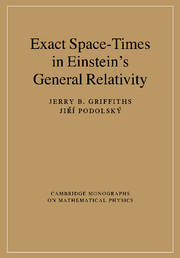Book contents
- Frontmatter
- Contents
- Preface
- 1 Introduction
- 2 Basic tools and concepts
- 3 Minkowski space-time
- 4 de Sitter space-time
- 5 Anti-de Sitter space-time
- 6 Friedmann–Lemaître–Robertson–Walker space-times
- 7 Electrovacuum and related background space-times
- 8 Schwarzschild space–time
- 9 Space-times related to Schwarzschild
- 10 Static axially symmetric space-times
- 11 Rotating black holes
- 12 Taub–NUT space-time
- 13 Stationary, axially symmetric space-times
- 14 Accelerating black holes
- 15 Further solutions for uniformly accelerating particles
- 16 Plebański–Demiański solutions
- 17 Plane and pp-waves
- 18 Kundt solutions
- 19 Robinson–Trautman solutions
- 20 Impulsive waves
- 21 Colliding plane waves
- 22 A final miscellany
- Appendix A 2-spaces of constant curvature
- Appendix B 3-spaces of constant curvature
- References
- Index
18 - Kundt solutions
Published online by Cambridge University Press: 04 February 2010
- Frontmatter
- Contents
- Preface
- 1 Introduction
- 2 Basic tools and concepts
- 3 Minkowski space-time
- 4 de Sitter space-time
- 5 Anti-de Sitter space-time
- 6 Friedmann–Lemaître–Robertson–Walker space-times
- 7 Electrovacuum and related background space-times
- 8 Schwarzschild space–time
- 9 Space-times related to Schwarzschild
- 10 Static axially symmetric space-times
- 11 Rotating black holes
- 12 Taub–NUT space-time
- 13 Stationary, axially symmetric space-times
- 14 Accelerating black holes
- 15 Further solutions for uniformly accelerating particles
- 16 Plebański–Demiański solutions
- 17 Plane and pp-waves
- 18 Kundt solutions
- 19 Robinson–Trautman solutions
- 20 Impulsive waves
- 21 Colliding plane waves
- 22 A final miscellany
- Appendix A 2-spaces of constant curvature
- Appendix B 3-spaces of constant curvature
- References
- Index
Summary
Solutions are said to belong to Kundt's class if they admit a null geodesic congruence, generated by a vector field k, which is shear-free, twist-free and expansion-free. They include the pp-waves and plane wave space-times that have been described in the previous chapter. The whole class, initially investigated by Kundt (1961, 1962) in the case of vacuum or with an aligned pure radiation field, is however much wider. Because the null vector field k is not in general covariantly constant, the rays of the corresponding non-expanding waves are not necessarily parallel, as in the case of pp-waves, and the wave surfaces need not be planar. This greater freedom permits, for example, the presence of a cosmological constant Λ or aligned electromagnetic fields, both null and non-null.
For vacuum or some specific matter content, generalised Goldberg—Sachs theorems imply that the Kundt space-times must be algebraically special, that is of Petrov type II, D, III or N (or conformally flat), with k being a repeated principal null direction of the Weyl tensor. Any Einstein—Maxwell and pure radiation fields must also be aligned: that is, k is the common eigendirection of the Weyl and Ricci tensor.
A number of physically interesting space-times of this class are explicitly known. These will be briefly described in this chapter, with emphasis given to those that describe exact non-expanding gravitational waves of various kinds.
- Type
- Chapter
- Information
- Exact Space-Times in Einstein's General Relativity , pp. 336 - 360Publisher: Cambridge University PressPrint publication year: 2009

